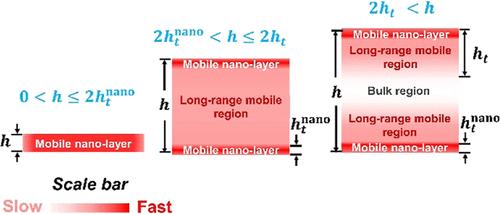Exploring Long-Range Surface-Induced Mobility Enhancement in Poly(methyl methacrylate)
IF 5.2
1区 化学
Q1 POLYMER SCIENCE
引用次数: 0
Abstract
The mechanical relaxation behavior of freestanding poly(methyl methacrylate) (PMMA) films and freestanding PMMA supported by a polydimethylsiloxane micrometer film was investigated by using dynamic mechanical analysis (DMA). Results reveal two tiers of enhanced molecular mobility near the surface: a significant enhancement in the nanoscale outer region and a lesser enhancement in a thicker region (thickness, ht ∼ 140 nm) underneath, consistent with observations made in polystyrene (PS) films, where ht ∼ 1000 nm, however. Coarse-grained molecular dynamics simulations of PMMA and PS suggest that fast-moving molecules in the nanoscale surface region activate adjacent molecules, facilitating collective motion in both polymers. For PMMA, this enhancement terminates at a distance consistent with the experimental observation. In contrast, for PS, this dynamic enhancement persists up to the simulated thickness of 250 nm, showing no sign of termination. These findings support the role of near-surface collective motions in driving long-range mobility enhancement, with greater enhancement observed in PS compared to PMMA, accounting for the different ht values.

远距离表面诱导的聚甲基丙烯酸甲酯迁移率增强研究
采用动态力学分析(DMA)方法研究了独立聚甲基丙烯酸甲酯(PMMA)薄膜和聚二甲基硅氧烷微微米薄膜负载的独立PMMA的力学松弛行为。结果显示,表面附近有两层分子迁移率增强:纳米级外区域显著增强,下方较厚区域(厚度,ht ~ 140 nm)增强较小,这与聚苯乙烯(PS)薄膜中ht ~ 1000 nm的观察结果一致。PMMA和PS的粗粒度分子动力学模拟表明,纳米级表面区域快速移动的分子激活相邻分子,促进两种聚合物中的集体运动。对于PMMA,这种增强终止于与实验观测一致的距离。相比之下,对于PS,这种动态增强持续到模拟厚度为250 nm,没有终止的迹象。这些发现支持近地表集体运动在驱动远程迁移性增强中的作用,与PMMA相比,PS中观察到的增强更大,这说明了不同的ht值。
本文章由计算机程序翻译,如有差异,请以英文原文为准。
求助全文
约1分钟内获得全文
求助全文
来源期刊

Macromolecules
工程技术-高分子科学
CiteScore
9.30
自引率
16.40%
发文量
942
审稿时长
2 months
期刊介绍:
Macromolecules publishes original, fundamental, and impactful research on all aspects of polymer science. Topics of interest include synthesis (e.g., controlled polymerizations, polymerization catalysis, post polymerization modification, new monomer structures and polymer architectures, and polymerization mechanisms/kinetics analysis); phase behavior, thermodynamics, dynamic, and ordering/disordering phenomena (e.g., self-assembly, gelation, crystallization, solution/melt/solid-state characteristics); structure and properties (e.g., mechanical and rheological properties, surface/interfacial characteristics, electronic and transport properties); new state of the art characterization (e.g., spectroscopy, scattering, microscopy, rheology), simulation (e.g., Monte Carlo, molecular dynamics, multi-scale/coarse-grained modeling), and theoretical methods. Renewable/sustainable polymers, polymer networks, responsive polymers, electro-, magneto- and opto-active macromolecules, inorganic polymers, charge-transporting polymers (ion-containing, semiconducting, and conducting), nanostructured polymers, and polymer composites are also of interest. Typical papers published in Macromolecules showcase important and innovative concepts, experimental methods/observations, and theoretical/computational approaches that demonstrate a fundamental advance in the understanding of polymers.
 求助内容:
求助内容: 应助结果提醒方式:
应助结果提醒方式:


